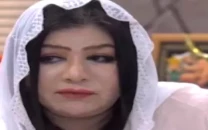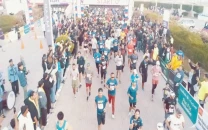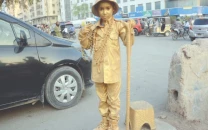Karachi: Mixed and matchless
“Karachi is a mini-Pakistan.” You may roll your eyes at this, but that doesn’t make it any less true.

Karachi: Mixed and matchless
There are two such structures in central Karachi, dating back to over a hundred years ago. The small Tower known as the “Ghadialy Dokhma,” along a ridge studded with green trees, was consecrated in 1847 and the bigger Tower, known as the “Anjuman Dokhma” was consecrated in 1875. The Tower of Silence or dokhma is a perfectly white cylinder with a flat top but for a rounded lip that juts up above the entrance. Inside, bodies are laid out under the open roof to decompose by the powers of nature.
Bones fall through a grate into a well below. “People don’t like to build houses here.” A Parsi friend indicated the barren plot below the ridge. “The smell.”
Until 1999, there were vultures on the Indian subcontinent. But in the next ten years, as a result of feeding on cattle treated with a particular chemical called diclofenac, they were nearly completely annihilated. In India, some form of solar contraption is now used to “evaporate the body,” as our guide said — some reports say they are mirrors that focus the sunlight, others whisper of something more complex. No one is allowed inside the Towers of Silence but those trusted with its upkeep, so there’s no way of knowing what lies beyond those raised white walls. The birds, it seems, are there just to look.
The term ‘Parsi’ is today used interchangeably with “Zoroastrian”, though it traces its roots to the Fars or Pars Province in south-west Iran but today only those who fled to the Indian subcontinent in the seventh and eight centuries are referred to as Parsis. Numbering only in the low thousands, the Parsi community is nonetheless thriving and prominent, distinctly less affected by extremist attacks than other religious minorities in Pakistan.
In Karachi, Parsi, Hindu, Sikh, and Christian are all within striking distance — er, short drives — of each other. Though its inhabitants are almost entirely Muslim, Karachi’s demography reflects the gravitation of myriad immigrant populations to this Sindhi city by the sea, now one of the world’s top five most populous. This genealogy extends back through nations and empires, including the country’s own provinces, that existed long before Pakistan — and it is by no means forgotten. In one corner of a house, the cook speaks Sindhi to the maid. Downstairs, the driver jokes with a guard in Pashto. An obstacle to Pakistani unity, then — though by no means to its heart and spirit — is perhaps that too much is remembered.
The monumental mausoleum of Abdullah Shah Ghazi looks out over Clifton beach from its hilltop on Khayaban-e-Firdousi street. Crowned by two solid green flags, the exterior is entirely navy-blue tile and patterns of thick, white zigzags. In 2010, a double suicide bombing claimed several lives. Still, all day and night, past the defunct metal detector and cursory pat-downs, crowds leave their shoes below and climb to the shrine to pray to the eighth century mystic saint, under whose aegis, many believe, tropical disasters have spared Karachi for more than a millennium. My friend, a born and raised Karachiite, seemed nervous. “Don’t tell my dad we went here.”
One Hindu mandir, hides quietly down a small street near Jail Roundabout, albeit marked with colorful paint and a white dome peeking up over the mute blue walls. The gatekeeper wrenched open the latch and followed us with watchful eyes as we shuffled in. We took off our shoes and walked past the glittery, foil swastikas on the walls into a small shrine, dim and crowded with the stems and smells of leftover offerings.
Twenty minutes away through the city’s infamous traffic are the gates to Saint Patrick’s Cathedral. A catholic man with a dark, happy face guarded the entrance with a dog that looked delighted to nap with its head on its paws. The man’s name was Diego Rodriguez and he welcomed us onto the impressive grounds of the gothic church, in front of which rise the stately staircases of a white marble monument. We couldn’t go in, though — the church is closed except for Sunday mass because of two recent attacks. “It is sad,” said Diego.
Rumours were that a synagogue would be near the Bhimpura Old Town, but we never found it. Wikipedia says it may have survived until the 1980s. Diversity, too, has its bounds.
I remembered the plaque that stood at the foot of the newest Tower of Silence. Unequal in life. There is a kind of inequality stitched to the heart of this city, a hand extended to some, and withdrawn from the grasp of others. But there was more written on that marble slab, in letters accented with black ink: NO SPECIAL PLACE FOR ANYONE. NO MINE, NO THINE, NO HIS, NO HERS, ALL INSEPARABLE AND INDISTINGUISHABLE, SLEEP SIDE BY SIDE, PARTNERS AND EQUALS. Sure, these words honoured the idyll of death, but men in Karachi also stand side by side.
We walked back onto the street, a Jewish tourist and his Muslim host. We nodded to pedestrians in passing, Baloch, Sindhis, Hindus, Christians, Sikhs. At least, they might have been — I had no idea. Perhaps they don’t either.
Published in The Express Tribune, Sunday Magazine, August 14th, 2011.



















COMMENTS
Comments are moderated and generally will be posted if they are on-topic and not abusive.
For more information, please see our Comments FAQ